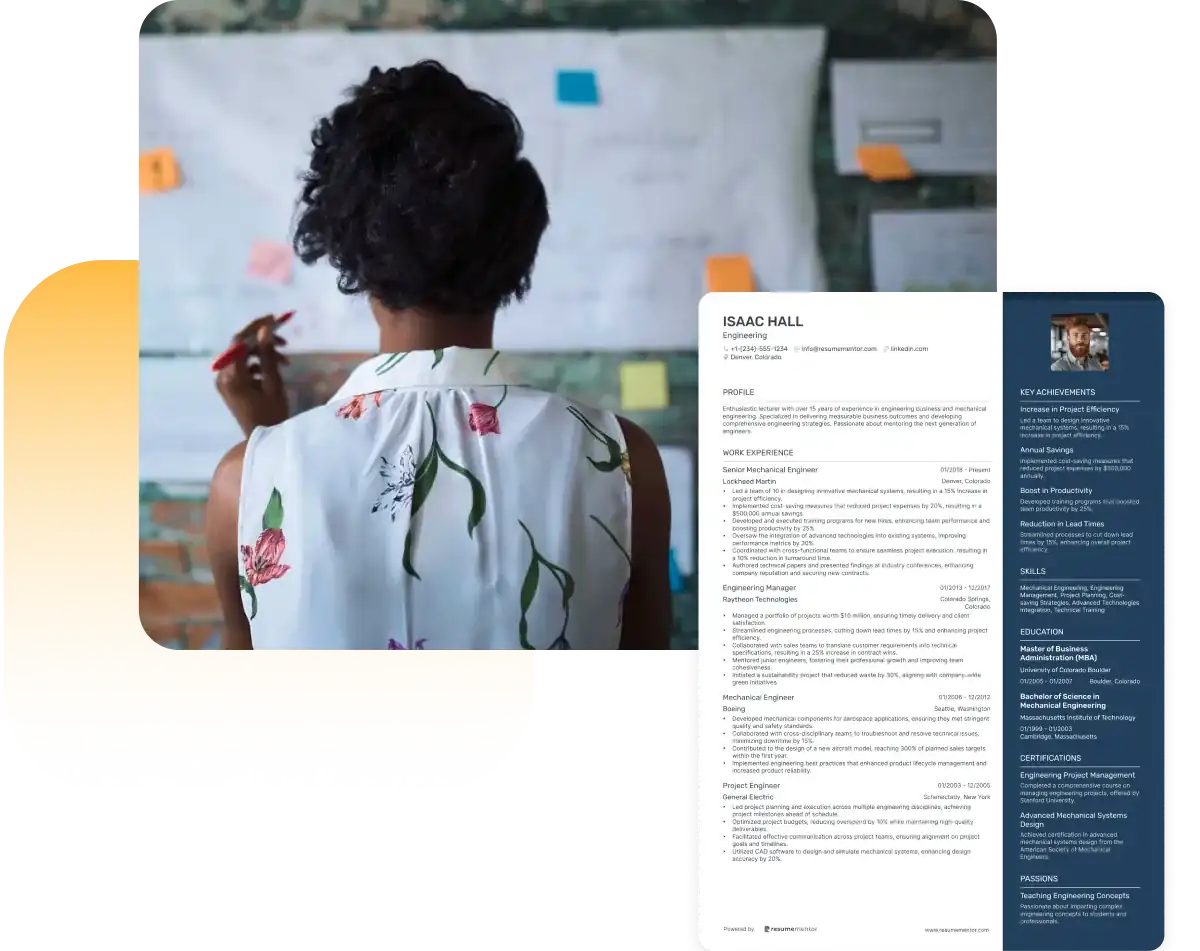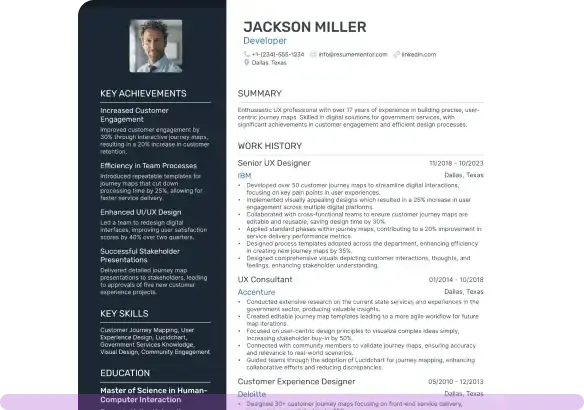The Essential Guide to Including Education on Your Resume

Jun 25, 2025
|
12 min read
How to list, format, and customize your Education section for every stage of your career.
A well-structured resume isn't just about listing experiences—it's about telling a story of your skills, growth, and potential. At the heart of that story is your educational background, which often serves as the foundation of your qualifications, especially for early-career professionals.
Whether you’re fresh out of school or transitioning into a new industry, knowing how to list education on a resume—strategically and clearly—can set your application apart. In this guide, you’ll learn where to place your education section, how to format it, what to include, and how to handle unique education scenarios.
Key takeaways
- Always list education in reverse-chronological order, starting with your highest degree.
- If you're still pursuing a degree, include your expected graduation date.
- Include honors like Dean’s List, cum laude, or a GPA on your resume (if 3.5 or higher).
- Highlight relevant coursework to show job-readiness.
- Tailor your education section to the role you’re targeting.
- Use consistent formatting, spacing, and a clean resume layout for impact.
The role of education in your resume strategy
Before diving into formatting details, it’s important to understand the purpose of the resume education section. This part of your resume does more than show you’ve graduated—it demonstrates your expertise, learning discipline, and commitment to personal growth.
For students or recent graduates, it may be the strongest section. For professionals, it should reinforce credibility and show development over time. Either way, aligning your education summary with the job description helps your qualifications stand out.
Formatting your resume education section
Your education entries should be consistent, clean, and easy to scan.
Use the following structure:
- Degree type
- Field of study
- School name and location
- Graduation date (or expected date)
- Optional: GPA (if above 3.5), academic honors, relevant coursework, academic awards
- •Academic Honors: Cum Laude
- •Relevant coursework: Artificial Intelligence, Machine Learning, Software Engineering
Use a legible resume font, standard resume margins, and aligned formatting throughout to ensure ATS compatibility and readability.
Where to position the education section on your resume
The placement of your education section depends on your career stage and the role you're applying for. Proper placement ensures your most relevant strengths are seen first and reinforces a strategic, well-organized resume.
Entry-level candidates
If you’re just starting out—whether you’re still in school or recently graduated—place your education section at the top of your resume, right after your resume summary or objective.
- •Dean’s List (2022–2024)
- •Relevant coursework: Thermodynamics, CAD Design, Materials Science
- •Led a team of 8 educators in curriculum improvements, resulting in a 10% increase in student satisfaction scores.
- •Designed and implemented an advanced English test prep course, leading to a 95% pass rate on standardized exams.
- •Mentored 12 first-year teachers, helping 90% of them achieve ‘proficient’ or above in their evaluations.
- •Organized annual interschool debates and literature festivals, boosting student participation by 40%.
- •Developed IB-specific lesson plans that increased student engagement and understanding, evidenced by a 25% rise in IB test scores.
- •Managed classroom behavior effectively, reducing incidents of misconduct by 60%.
- •Implemented a differentiated learning strategy that improved academic performance by 15% across all grade levels.
- •Authored school-wide English curriculum guidelines that elevated teaching consistency and quality.
- •Conducted after-school tutoring sessions resulting in a 20% improvement in exam results for stressed students.
- •Integrated technology in lesson delivery, increasing engagement in over 75% of students.
- •Collaborated with special education staff to adapt materials for diverse learners, resulting in a 30% improvement in their test scores.
- •Developed a thematic teaching method that increased literature comprehension by 20%.
- •Coordinated school-wide campaigns for literacy awareness, improving reading scores among freshmen by 30%.
- •Led professional development workshops for 25 teachers to share best practices in English instruction.
- •Directed the school’s creative writing club, increasing membership by 50% over two years.
- •Instructed students in grades 9-12 in English language arts with a 98% course completion rate.
- •Crafted comprehensive lesson plans that catered to various learning styles, improving overall class GPA by 1.2 points.
- •Facilitated study groups that resulted in a 25% improvement in test scores.
- •Participated in a cross-curricular initiative to integrate literature with history, increasing student interest in both subjects.
If you need inspiration, check out our High School Resume Template and one-page resume templates for early-career applicants.
Experienced professionals
If you have several years of work experience, place the education section below your work experience. Employers will be more focused on your recent roles and accomplishments.
However, you should still include:
- Graduate degrees (if applicable)
- Licenses and certifications
- Prestigious alma maters
Use a simple education heading, such as “Education” or “Education & Certifications.”
- •Relevant Coursework: Finite Element Analysis, Thermodynamics II, Advanced Fluid Mechanics, Computational Heat Transfer, Mechanical System Design
- •Academic Honors: Dean’s List (5 semesters), Tau Beta Pi Engineering Honor Society
- •Relevant Coursework: Mechanics of Materials, Machine Design, Materials Science, Control Systems, CAD/CAM
Note: Format a certification entry by listing the certification name, issuing organization, and date earned, optionally including a license number or expiration date if relevant.
- •Led a team of 8 educators in curriculum improvements, resulting in a 10% increase in student satisfaction scores.
- •Designed and implemented an advanced English test prep course, leading to a 95% pass rate on standardized exams.
- •Mentored 12 first-year teachers, helping 90% of them achieve ‘proficient’ or above in their evaluations.
- •Organized annual interschool debates and literature festivals, boosting student participation by 40%.
- •Developed IB-specific lesson plans that increased student engagement and understanding, evidenced by a 25% rise in IB test scores.
- •Managed classroom behavior effectively, reducing incidents of misconduct by 60%.
- •Implemented a differentiated learning strategy that improved academic performance by 15% across all grade levels.
- •Authored school-wide English curriculum guidelines that elevated teaching consistency and quality.
- •Conducted after-school tutoring sessions resulting in a 20% improvement in exam results for stressed students.
- •Integrated technology in lesson delivery, increasing engagement in over 75% of students.
- •Collaborated with special education staff to adapt materials for diverse learners, resulting in a 30% improvement in their test scores.
- •Developed a thematic teaching method that increased literature comprehension by 20%.
- •Coordinated school-wide campaigns for literacy awareness, improving reading scores among freshmen by 30%.
- •Led professional development workshops for 25 teachers to share best practices in English instruction.
- •Directed the school’s creative writing club, increasing membership by 50% over two years.
- •Instructed students in grades 9-12 in English language arts with a 98% course completion rate.
- •Crafted comprehensive lesson plans that catered to various learning styles, improving overall class GPA by 1.2 points.
- •Facilitated study groups that resulted in a 25% improvement in test scores.
- •Participated in a cross-curricular initiative to integrate literature with history, increasing student interest in both subjects.
How to list multiple degrees
If you’ve earned multiple degrees, list them in reverse chronological order, starting with the most recent.
Master of Business Administration (MBA), Harvard University, 2021
- Relevant coursework: Strategic Management, Marketing Analytics
Bachelor of Science in Computer Science, Stanford University, 2018,
- Academic honors: Cum Laude
- Relevant coursework: Data Structures, Algorithms, Systems Design
If one of your degrees is incomplete, indicate that clearly to avoid confusion.
Listing different types of education and scenarios
Every education path is unique. Here’s how to handle common variations such as incomplete degrees, associate’s degrees, certifications, and online programs.
Completed degrees
For finished degrees, list:
- Full degree name
- University name and location
- Graduation year
- Optional: GPA, honors, relevant coursework
✔️ Use reverse-chronological order for clarity and impact.
In-progress degrees
If you're still enrolled, indicate your expected graduation date and current academic standing.
Example:
Master of Arts in Psychology, NYU | Expected May 2026
Completed 30 of 45 credits; GPA: 3.9
Incomplete degrees
Be transparent if you didn’t finish a program.
Example:
Bachelor of Fine Arts, University of Arizona | Completed 80 credits toward degree
2019–2021 (left program in good standing)
Associate’s degrees
Example:
Associate of Applied Science in Nursing, City College of San Francisco, 2021
Licensed Practical Nurse (LPN) certification obtained
Online degrees
Example:
Bachelor of Business Administration, University of Phoenix (Online), 2023
Relevant coursework: E-Commerce, Strategic Planning
Transfer schools
Only list the school that awarded your degree unless there's a compelling reason to include the transfer.
Example:
Bachelor of Arts in Sociology, University of Minnesota, 2022
Transferred from the University of Oregon
Continuing education
List online certificates and short-term programs under “Certifications” or “Professional Development.”
Example:
Google UX Design Certificate, Coursera, 2024
Completed as part of continuing education
Including high school education
Still in high school or recently graduated?
Here's how to list your high school diploma on a resume:
- •National Honor Society, AP Scholar
- •Extracurriculars: Debate Team Captain
This section shows initiative, leadership, and your level of education on your resume, even if you lack work experience.
Adding certifications and licenses
Certifications and licenses validate your expertise and show a commitment to continuous learning. These credentials belong in a separate “Certifications” section or paired with education.
PRO TIP
Use clear formatting and include details such as issuing authority and expiration date.
For more formatting options, explore our Combination Resume Template and Hybrid Resume Template.
Displaying GPA and academic achievements
A strong GPA on your resume (3.5 or higher) can bolster your candidacy, especially if paired with honors or awards.
- •Academic honors: Dean’s List (2019–2021) | Cum Laude
- •Full Merit Scholarship
- •Best Senior Thesis Award
Group awards into bullet lists for clarity. If your GPA is lower, focus on other achievements or relevant coursework.
Listing minors and double majors
Minors and double majors showcase breadth and versatility.
Minor example:
Bachelor of Arts in Political Science, Minor in Economics
University of California, 2020
Double major example:
Bachelor of Science in Computer Science and Mathematics
University of Illinois, 2021
Add capstone projects, leadership roles, or research if applicable.
Formatting academic honors
Keep your honors clear and aligned with your degree information.
Use bullet points or short descriptions. Be concise but specific.
Highlighting achievements and additional credentials
Your academic history doesn’t stop with degrees. Showcasing honors and awards, academic achievements, and additional credentials helps your education section stand out—especially when work experience is limited. This also boosts your credibility and demonstrates well-rounded growth and commitment.
Here’s how to enrich your education section with additional value:
1. Academic awards and honors
Achievements like Dean’s List, cum laude, and merit-based scholarships show academic excellence and consistency.
- •Academic honors: Summa Cum Laude | Dean’s List (2021–2023)
- •Academic Excellence Scholarship
- •Phi Beta Kappa Honor Society
PRO TIP
List these directly under the degree using bullet points. If space is tight, group under a subsection labeled “Honors & Awards.”
2. Research papers or theses
Have you written a notable thesis or published academic research? These accomplishments illustrate your analytical skills and subject-matter expertise.
- Senior Honors Thesis: “The Socioeconomic Effects of Public Housing Policy in the 21st Century”
- Received departmental distinction for original research and policy analysis
PRO TIP
Include a short title and topic summary. You can also mention if your paper won an award or was published.
3. Relevant projects and academic coursework
Academic projects can function like job experience—especially for STEM, business, or design roles. Use them to highlight relevant coursework and practical application.
- Capstone Project: Developed a marketing campaign strategy for a local nonprofit, resulting in a 20% increase in donor engagement
- Relevant Coursework: Consumer Psychology, Strategic Marketing, Branding & Identity
PRO TIP
Use action-oriented descriptions that mirror achievements on a resume.
4. Extracurricular activities and affiliations
Leadership roles in clubs, student organizations, or national societies reflect skills in teamwork, communication, and responsibility.
Example:
- President, Economics Student Association
- Treasurer, Women in Tech Club
- Member, Beta Gamma Sigma Business Honor Society
PRO TIP
These can be included under education or listed in a separate “Affiliations” or “Activities” section—especially if you’ve held leadership positions.
5. Certifications and continuing education
If you’ve earned certifications or completed professional development programs while in school, include them near your education section or under a combined heading.
Google Analytics Certification, Google (2023)
Certified Digital Marketing Associate, Meta (2024)
PRO TIP
Mention credentials, even if they’re not directly academic—they still signal proactive learning.
When to create a separate section
If your academic achievements, certifications, or extracurricular activities are extensive, consider creating one of the following:
- “Honors & Awards”
- “Projects & Research”
- “Academic Affiliations”
- “Certifications & Training”
Just make sure everything flows smoothly in your resume outline and reinforces the main narrative of your candidacy.
Common mistakes and tips for listing education
Mistakes in your education section can cost you interviews.
Inconsistent formatting
Keep education details formatting aligned—same font, punctuation, and order.
Missing information
Always include the degree you received, date you graduated, name of the school, and school location.
Misplaced section
Use strategic education section placement based on your experience level.
Vague headings
Avoid headings like "My Education Journey"—use “Education” or “Education & Certifications.”
Omitting ongoing degrees
If you’re still studying, say so and include your expected graduation date.
Including too much
Keep your education summary lean and job-relevant. Don’t list every class or outdated high school project.
Misrepresenting credentials
Honesty is critical. Don’t exaggerate or lie about degrees or dates.
Ignoring ATS
Use standard keywords like bachelor’s degree, high school education, and certifications to pass applicant tracking systems.
Tailoring education for entry-level vs. experienced candidates
Tailoring your education section based on your experience level ensures that the most relevant qualifications—whether academic or professional—are prioritized to capture a hiring manager’s attention quickly.
Entry-level strategy:
- Emphasize relevant coursework.
- Include projects, honors, and GPA.
- Highlight the education summary statement in the top section.
Experienced strategy:
- Keep the section brief and professional.
- Focus on graduate degrees and continuing education.
- Add certifications aligned with your role.
This type of resume tailoring ensures that your education supports your broader narrative.
Conclusion
Your education section is more than a list of schools—it’s a strategic resume component that signals your potential. Whether you’re listing a high school diploma, a master’s degree, or an incomplete program, formatting and placement matter.
From relevant coursework to certifications, honors, and ongoing education, presenting your background with clarity and strategy is key.
PRO TIP
If you want help building a polished, ATS-ready document, try our free resume-building tool—a simple way to format your resume outline and let your education shine.
Related Articles

Continue Reading
Check more recommended readings to get the job of your dreams.
Resume
Resources
Tools
© 2026. All rights reserved.
Made with love by people who care.
